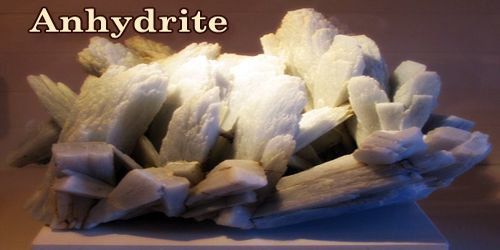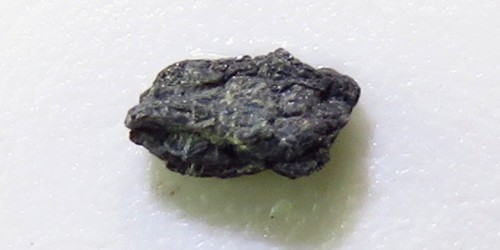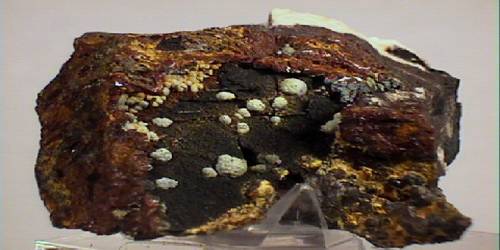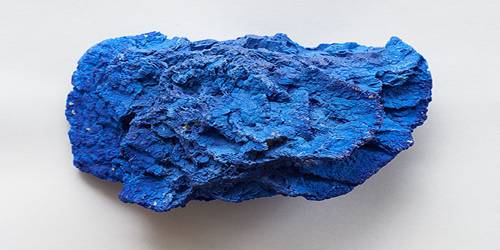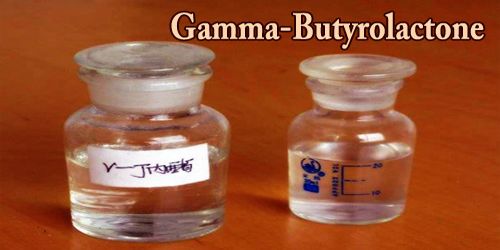Definition –
Anhydrite, or anhydrous calcium sulfate, is an evaporite mineral with the chemical formula CaSO4, that occurs in extensive layered deposits in sedimentary basins where large volumes of seawater have been evaporated. It is in the orthorhombic crystal system, with three directions of perfect cleavage parallel to the three planes of symmetry. It is typically interbedded with halite, gypsum, and limestone in accumulations that can be up to hundreds of feet thick. On a much smaller scale, anhydrite can form in shoreline or tidal flat sediments from the evaporation of seawater.
Anhydrite is one of the major minerals in evaporite deposits; it also is present in dolomites and limestones, and as a gangue mineral in ore veins. It occurs most often with salt deposits in association with gypsum, as in the caprock of the Texas-Louisiana salt domes. It is used in plasters and cement as a drying agent. Anhydrite crystals possess orthorhombic symmetry. It is deposited from solution, often along with calcite and halite, as gangue in sulfide mineral deposits. Anhydrite is also found in the caprock of salt domes and in cavities of trap rock.
Anhydrite receives its name from the Greek “anhydrous” which means “without water.” It readily converts to gypsum under humid conditions or in contact with groundwater. This transition involves the absorption of water and a significant change in volume. That expansion can cause deformation in the rock units. If gypsum is heated to about 200 degrees Celsius, it will yield water and be converted to anhydrite. This reaction occurs much less often.
Distinctly developed crystals are somewhat rare, the mineral usually presenting the form of cleavage masses. The Mohs hardness is 3.5, and the specific gravity is 2.9. The color is white, sometimes greyish, bluish, or purple. On the best developed of the three cleavages, the lustre is pearly; on other surfaces it is glassy. When exposed to water, anhydrite readily transforms to the more commonly occurring gypsum, (CaSO4·2H2O) by the absorption of water. This transformation is reversible, with gypsum or calcium sulfate hemihydrate forming anhydrite by heating to around 200 °C (400 °F) under normal atmospheric conditions.
Occurrence and Properties of Anhydrite –
Anhydrite actually occurs in a tidal flat environment in the Persian Gulf sabkhas as massive diagenetic replacement nodules. Cross-sections of these nodular masses have a netted appearance and have been referred to as chicken-wire anhydrite. Nodular anhydrite occurs as a replacement of gypsum in a variety of sedimentary depositional environments.

Calcium sulphate from an aqueous solution is deposited as crystals of gypsum, but when the solution contains an excess of sodium or potassium chloride, the anhydride is deposited when the temperature is above 40° C (104° F). This is one of the various methods in which the mineral is artificially prepared and is the same as its origin in nature. It is common in mineral salt basins. The anhydride is also formed as a vein filling mineral in hydrothermal deposits. The solution is usually left as a gangue in sulphide mineral deposits with calcite and halite. The anhydrite is also present in the caprock and trap rock cavities of the salt domes.
Massive amounts of anhydrite occur when salt domes form a caprock. Anhydrite is 1-3% of the minerals in salt domes and is generally left as a cap at the top of the salt when the halite is removed by pore waters. The typical cap rock is a salt, topped by a layer of anhydrite, topped by patches of gypsum, topped by a layer of calcite. Interaction with oil can reduce SO4 creating calcite, water, and hydrogen sulfide (H2S).
Anhydrite has been also found in some igneous rocks, for example in the intrusive dioritic pluton of El Teniente, Chile and in trachyandesite pumice erupted by El Chichón volcano, Mexico.
One of the most distinctive properties of anhydrite is its cubic cleavage. It cleaves in three directions at right angles. This can easily be seen in coarsely crystalline specimens or with a hand lens in fine-grained specimens. This distinctive cleavage has earned anhydrite the nickname of “cube spar.”
Individual crystals, which are tabular and prismatic, are uncommon. Often fibrous, in parallel veins that break off into cleavage fragments, and as fan-like groupings. Also grainy, massive, nodular, as rectangular cleavage fragments, and as easily cleavable crystal groupings.
Anhydrite can be a small challenge to identify when it occurs in massive form. It can be confused with gypsum, calcite, or halite which it is almost always associated with. Compared to gypsum, anhydrite exhibits cleavage in three directions at right angles and has a greater hardness. Its right angle cleavage and lack of acid reaction allows it to be distinguished from calcite. Compared to halite, anhydrite is insoluble and slightly harder.
Naming History of Anhydrite: The name anhydrite was given by A. G. Werner in 1804, because of the absence of water of crystallization, as contrasted with the presence of water in gypsum. Some obsolete names for the species are muriacite and karstenite; the former, an earlier name, being given under the impression that the substance was a chloride (muriate). A peculiar variety occurring as contorted concretionary masses is known as tripe-stone, and a scaly granular variety, from Volpino, near Bergamo, in Lombardy, as vulpinite; the latter is cut and polished for ornamental purposes.
A semi-transparent light blue-grey variety from Peru is referred to by the trade name angelite.
Uses of Anhydrite –
Anhydrite is used for the production of sulfuric acid and as a filler in paper. Good specimens of this mineral are rare and are desirable to collectors. Some other uses of anhydrite are –
- Anhydride, some uses are the same as Gypsum. Both minerals are crushed for use as a soil treatment and for this purpose the anhydrite is superior.
- Gives more calcium per tonne in soil application. The anhydride also has a higher solubility which helps it quickly benefit the soil.
- Anhydrite is used as a drying agent in paints and gypsum.
- It is used in the construction industry such as plaster and wall.
Hydrofluoric acid is produced using fluorite and sulfuric acid. For every ton of hydrofluoric acid produced, about 3 1/2 tons of synthetic anhydrite is produced. For decades this synthetic anhydrite was considered to be a nuisance product that had a disposal expense. However, much of it is now dried in a kiln and used as a raw material for producing cement, plaster, and flooring. It is also used as a filler in the production of plastics and paper products.
Information Sources:
